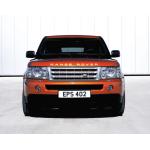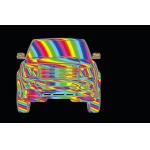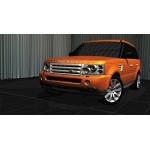Latest News
January 1, 2007
By Neil McLeod
The cars in the showrooms and on our roads today are a far cry from those that were built just a couple of decades ago. This is true for their technology, design, styling, and both their perceived and actual build quality. These improvements have come about in large part due to the integrated CAD/CAM/ CAE systems and supporting product data management (PDM) and product lifecycle management (PLM) systems used by the automotive industry. These have enabled the industry to achieve a previously unattainable — at least, economically unattainable — degree of quality in their vehicles.
< < The Range Rover Sport is Land Rover’s first high-performance SUV. Design development of the vehicle’s body and interior was carried out with the ICEM Surf surface modeling software suite.
But while integrated, solid modeling-based CAD/CAM/CAE systems are the mainstay of computer-aided product development and the manufacturing process, there are many steps in that process that benefit from, or even rely on, the use of niche software products from specialist developers. But how well do these niche products fit into the overall product development process — and more importantly, a manufacturer’s PLM system environment?
Surface ModelingOne of these niche areas is surface modeling. In the automotive industry, where styling and perceived quality are paramount in attracting buyer attention, this is the software environment in which the body and interior — in fact, all of the surfaces visible to the customer — are developed. Software developers such as ICEM Ltd. have devoted their entire existence — that’s some 20 years in the case of ICEM — to developing the algorithms needed to digitally create, diagnose, analyze, and visualize the high-quality, complex free-form shapes that characterize motor vehicles today.
Such software has become an essential part of the overall vehicle design and development process for all of the world’s major automotive OEMs and their Tier 1 suppliers. However, for both cultural (designers versus engineers) and practical (surface modeling versus solid modeling) reasons, the design development process for the body and interior of a vehicle is separated to a greater or lesser extent from the structural engineering design process for the vehicle. Of course, both come together at some stage, and this is where problems can arise.
> > An example of the use of ICEM Surf to analyze surface reflection lines visually in order to check the final quality of the vehicle in terms of how well the different components align and reflect their surroundings.
The process for designing a vehicle body and its interior starts with the stylist’s sketches and moves on through a more highly developed visualization stage to theme selection, which usually ends in the development of a clay styling model. From here on, if not before, the process moves fully into the digital environment, with what is known as “Class A” surface data required for final tooling design and production as the goal. During this process, surface model data will have been used to machine prototype components where necessary, as well as the final full-scale physical prototype, known variously as the function cube or stacking model.
Merging ProcessesToday’s surface modeling software enables automotive designers and manufacturers to merge the traditional clay styling and full-scale physical prototype process with digital surface modeling and real-time design visualization. This also means designers can modify the surface model without needing to re-create geometry, and it gives them the added benefit of analyzing for quality of the surface model assembly. This provides the opportunity for checking technicalities like surface-to-surface transitions, surface flatness and curvature, gap lines and surface fillets, and to take full account — early in the design development process — of the tooling conditions to avoid late design changes. And, through the ability to import and view lightweight model data, it enables designers to model surfaces in the context of the CAD/CAM solid model of the vehicle structure.
< < An ICEM Surf photorealistic visualization of the Range Rover Sport. Images such as this are produced for use in senior management design review meetings.
The value of such specialized surface-modeling capabilities should not be underestimated. For example, Ford Premier Automotive Group member Land Rover used it extensively during the development of the body and interior of the new Land Rover Discovery 3 and the new Range Rover Sport. As a result, the company was able to save several million dollars in tooling costs by being able to make high-quality surface model data available to downstream processes like tooling design well before the individual component designs had been approved.
Land Rover’s surface modeling software is ICEM Surf, while its engineering CAD/CAM system is Dassault Systemes’ CATIA. The vehicle master model is maintained in the CATIA file format, from where all data is released to manufacturing. Consequently, the ICEM Surf surface model data representing the vehicle body panels and interior components has to be exported from ICEM Surf’s internal database into the CATIA master model of the vehicle. Conversely, surfacing engineers must download the surface model from the CATIA master model database each time they need to work on it.
This data transfer is achieved using a direct (i.e., one-to-one) translator interface. Similar interfaces are available for users of other high-end solid modeling systems, including Pro/E and UGS Corp.’s NX and I-deas. And while these work well in most instances, they do introduce a disjoint — an unwelcome additional step in the design development workflow. This can lead to anything from minor irritations and delays to inconsistencies in data transfer.
To avoid this disjoint, an agreement was signed in March 2005 by ICEM Ltd. and Dassault Systemes under which the next generation of ICEM’s surface modeling software would be developed on Dassault’s CAA V5 software architecture — the architecture that underlies CATIA V5.
In December 2005, ICEM delivered a new suite of software, known as ICEM Shape Design, which address the end-to-end automotive Class A surface development process, from sketch tracing, scan modeling and reverse engineering, through Class A surface design and analysis to photorealistic visualization, all fully integrated with the CAA V5 environment.
For CATIA V5 users, this means that they no longer need to go through the additional step of data translation when passing ICEM surface model data into the CATIA V5 master model database. Designers and surfacing engineers using ICEM’s surface modeling software have direct access to the surface model data and any changes to the vehicle structure as they happen.
The benefits of this development are probably best summed up by Richard Riff, Henry Ford Technical Fellow, Virtual Product Creation & PLM, Ford Motor Company, who stated, “This partnership provides us with a best-in-class automotive Class A surface modeling solution that is fully integrated into our enterprise-wide CAD environment. As a result, we will be using native CATIA V5 data throughout the vehicle body and interior design development process, with no need for data translators. This will bring real benefits in terms of data integrity and consistency, as well as in terms of an improved workflow.”
And with CATIA being the most widely used collaborative product development software in the automotive industry, one specialist software developer will have met the desires of a large part of the industry to remove the barriers to design process integration.
Neil D. McLeod is a UK-based marketing communications and PR consultant who specializes in the CAD/CAM/CAE and PLM software and systems marketplace. Send your comments about this article through e-mail by clicking here. Please reference “Interaction is Key” in your message.
CATIA
Dassault Systemes
Paris, France
ICEM Surf
ICEM Ltd.
Southampton, UK
Subscribe to our FREE magazine, FREE email newsletters or both!
Latest News
About the Author
DE’s editors contribute news and new product announcements to Digital Engineering.
Press releases may be sent to them via [email protected].






